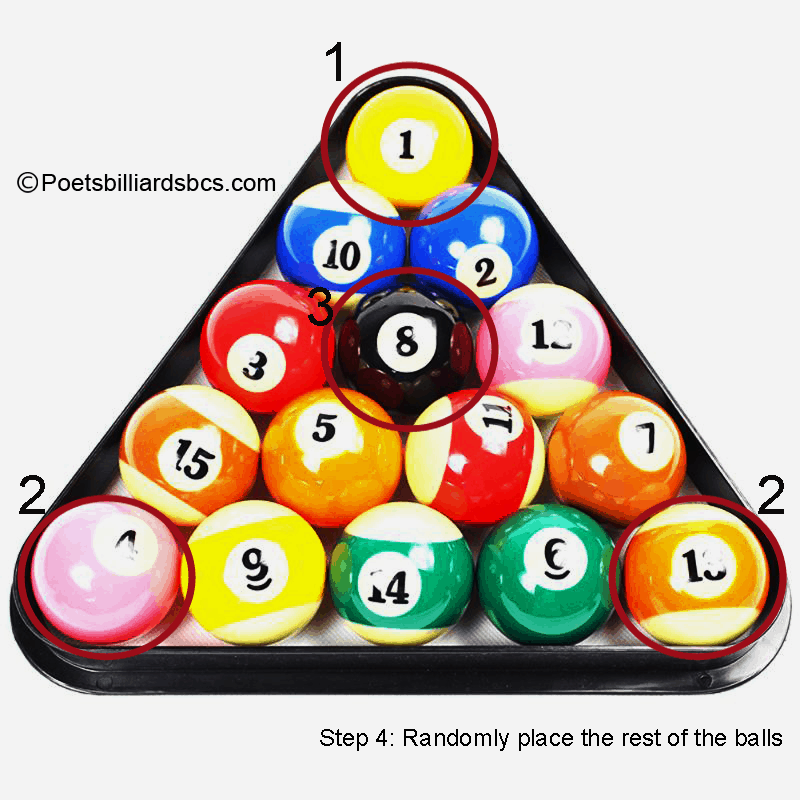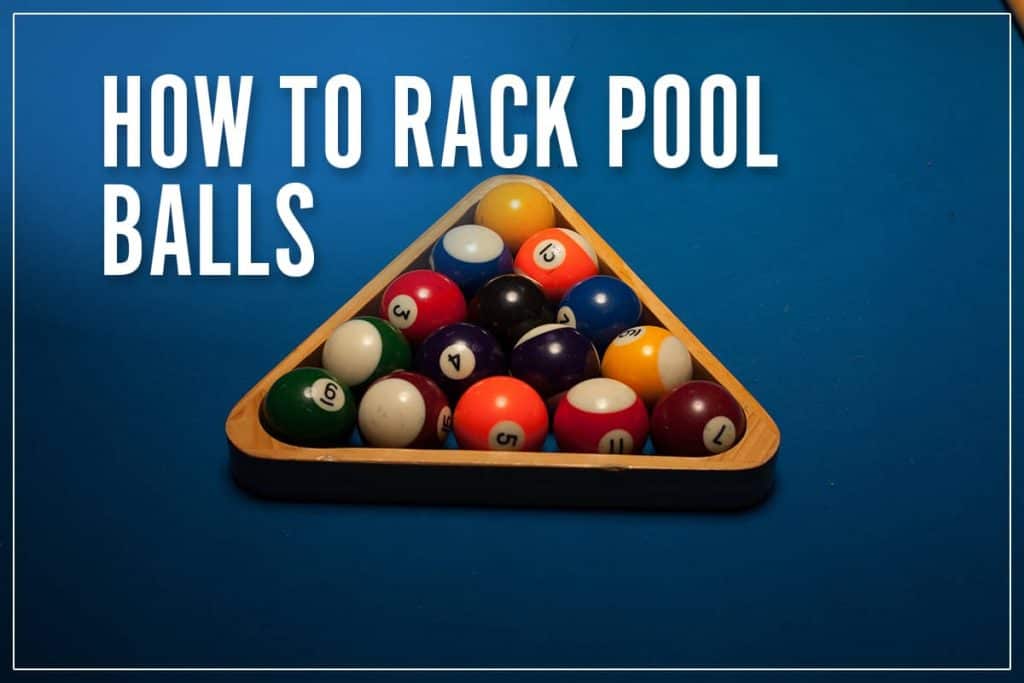Perfect Pool Rack: How-To Guide Expert Tips & Tricks
Ever wondered what separates a good pool player from a great one? Mastering the art of the perfect rack isn't just about aesthetics; it's the cornerstone of a successful game, setting the stage for your break and influencing the entire match.
There are nine key considerations when trying to achieve the perfect rack. A perfect rack is an essential skill for any pool player, laying the foundation for a successful break and subsequent game. It's not just about randomly arranging the balls; a tight, accurate rack can significantly impact your chances of winning. First, you must place the apex ball first; the rest of the balls should be tightly packed together. You can manually lock the balls in to ensure they stay in place. And finally, tapping the balls down to settle them.
This guide provides a comprehensive walkthrough on how to correctly rack pool balls, catering to various game types and adhering to the standards set by national and international associations. By understanding the intricacies of the rack, you can play by the book and potentially elevate your break to new heights. Following these steps will help you achieve a legal and tight rack, ensuring a fair and consistent break for both players. The focus is to set up the balls correctly to create a fair and consistent break for both players.
The correct way to set them up in the majority of leagues, tournaments and professional events throughout England, Ireland, Scotland, and Wales is as follows:
The first rack shown is the Old English Pool Association (EPA) ruleset. The second rack is for the WEPF and WPA rulesets (World Rules and Blackball Rules, respectively). The colors may be swapped around in the WEPF/WPA rack, as shown in the image. Usually, it's the yellow balls that form the "J" pattern. For best results, push the balls firmly forward as you remove the rack. Make sure to spread the balls randomly to prevent clustering. So, avoid placing a solid or stripe ball next to each other in a row. Before starting the game, slide the rack over the pool table to ensure the apex ball is on the foot spot. No need for hefting a heavy game table back and forth.
Old rules pool ball rack set up. This rack is also used for leagues and players that play old EPA rules (pub rules). The correct way to set them up in the majority of leagues, tournaments and professional events throughout England, Ireland, Scotland, and Wales is this: Place the other balls in a random order, ensuring a tight rack. Remove the rack and begin the game by striking the cue ball to make legal shots to pocket the balls in numerical order. Balls numbered 1 through 9. Standard size pool table with six pockets. Used to strike the cue ball. Some pool halls or bars will have a special diamond-shaped 9-ball rack, but 9-ball can also be racked utilizing a standard triangle rack. Magic Rack also makes a 9-ball rack.
Consider Corey Deuel's 8-ball pattern rack, for example. By placing solids and stripes in a very particular pattern, while maintaining the basic rules8-ball in the middle with a solid or stripe at the front and solid and stripe in the cornersand utilizing a soft break, Corey Deuel is able to sink a ball on the break and clump the opponent's balls near the centerline of the table.
In general, the key to a successful rack lies in moving the balls efficiently and positioning them precisely within the corners of the triangle. Move any spinning balls to the backside of the rack and then switch them out. Keep doing this until there is minimal ball movement. Align the balls and rack with the center mark, press balls forward, and remove the rack by the corner holes or the ergonomic grip.
A good rack is often the difference between a successful break and a missed opportunity. The following are the key considerations when trying to achieve the perfect rack:
- Apex Ball Placement: Ensuring the ball at the apex of the rack (the one at the front) is correctly positioned. The specific ball varies depending on the game.
- Tight Racking: Packing the balls as tightly as possible together. This minimizes the gaps between them, transferring energy more effectively during the break.
- Manual Locking: While not always possible, physically locking the balls in place before the break can further enhance the tightness of the rack.
- Tapping Down: Once the balls are positioned, lightly tapping them down can help settle them and reduce any minor inconsistencies.
- Adhering to Specific Rules: Different games (8-ball, 9-ball, etc.) have specific racking requirements. These must be followed.
- Randomization: Ensuring the balls are arranged randomly (within the constraints of the game) to prevent any strategic advantage for either player.
- Avoiding Clustering: Preventing balls of the same type (solids or stripes) from being adjacent to each other in a row can provide a more balanced break.
- Foot Spot Alignment: Correctly positioning the apex ball on the foot spot, which is a standard mark on the table.
- Practice: Practice these racking techniques to improve the consistency and effectiveness of your break.
Let's take a look at the most common types of pool games and their racking requirements:
8-Ball: The 8-ball is placed in the center of the rack. One corner must contain a solid, and the other must contain a stripe. The other balls are arranged randomly. The object of 8-ball is to pocket all of your group of balls (solids or stripes) and then legally pocket the 8-ball. This game is popular in pubs and bars around the world.
9-Ball: The 1-ball is placed at the apex of the rack, and the 9-ball is placed in the center. The other balls are arranged randomly, but they must be placed in a way that they do not touch each other. 9-ball is played with the goal of pocketing the balls in numerical order. The 9-ball must be pocketed to win.
Straight Pool (14.1 Continuous): The rack is similar to 8-ball, but the 1-ball is at the apex. After the first ball is pocketed on the break, the balls are racked again with the remaining balls, with the 1-ball at the apex. The object is to pocket balls consecutively and score points. 14.1 Continuous is a less common form of pool and requires a high degree of skill.
The tools of the game are a standard size pool table with six pockets, balls numbered 1-15, a cue stick, a triangle rack, and chalk. Some pool halls or bars have a special diamond-shaped 9-ball rack, but 9-ball can also be racked utilizing a standard triangle rack. Magic Rack also makes a 9-ball rack.
The following table details the requirements for racking in various pool games, focusing on the placement of specific balls and overall arrangement:
| Game Type | Apex Ball | Center Ball | Corner Balls | Other Notes |
|---|---|---|---|---|
| 8-Ball | Not specific, but traditionally placed on foot spot. | 8-ball | One solid and one stripe in opposite corners. | Rest of the balls arranged randomly, ensuring a mix of solids and stripes. |
| 9-Ball | 1-ball | 9-ball | Not specified | Balls arranged randomly, with the 9-ball in the center. |
| Straight Pool (14.1) | 1-ball | Not specified | Not specified | After the first ball is pocketed, remaining balls are racked with the 1-ball at the apex. |
| Blackball (WEPF/WPA) | Not specified | Black 8-ball (in the center) | One red and one yellow ball in opposite corners. | Rest of the balls arranged randomly. Colors may be swapped around. |
The importance of a tight rack cannot be overstated. A properly packed rack ensures that the balls are in close contact, maximizing the transfer of energy from the cue ball during the break. This leads to a more dynamic and potentially more favorable break, increasing your chances of pocketing a ball on the first shot and controlling the table. A tight rack makes it more difficult for your opponent to get a clean shot.
Practice and repetition are key to mastering the perfect rack. Experiment with different techniques and pay attention to the results. Analyzing how the balls scatter on the break will help you refine your approach. Consistently practicing your rack will improve your overall game.
Look up Corey Deuel's 8-ball pattern rack. Placing solids and stripes in a particular pattern, while maintaining the basic rules, enables him to sink a ball on the break and clump the opponent's balls near the centerline of the table.
In conclusion, perfecting the rack is not just about the technicalities of arranging the balls; it's about setting the stage for a successful and strategic pool game. A precise and deliberate approach to racking will enhance your overall performance and increase your chances of winning. The next time you step up to the table, remember these key considerations and elevate your game.
Here's a breakdown of each component:
Apex Ball Placement
The apex ball is the ball at the very front of the triangle, directly on the foot spot (the spot on the table where the balls are racked). The key to consistent and controlled play is to always have the apex ball on the foot spot.
Tight Racking
The balls should be packed as tightly as possible within the triangle. There should be no gaps between the balls to maximize the energy transfer during the break. This is why many players use a racking template, also called a Magic Rack, to help. Some players even use a "rack lock" which locks the balls into place.
Manual Locking
Before the break, ensure that the balls are snug against each other and cannot move. A tight rack will give you better control and spread the balls more evenly. This can be achieved by slightly pressing the balls together and applying a small amount of pressure to lock them in place. This makes it more difficult to break, but it improves the odds of making balls.
Tapping Down
Once the balls are in place, a gentle tap down on the top of the rack helps the balls settle and reduces any minor imperfections in the setup. This is often done after the rack is in place and before the cue ball is struck. This helps to ensure that the balls stay put.
By following these steps and the rules of the game, you can master the rack, which will give you a significant advantage on the pool table.
Beyond the basic racking principles, understanding the nuances of different pool variations is crucial. For instance, in 9-ball, the 1-ball must be at the apex, and the 9-ball must be in the center of the rack. In 8-ball, the 8-ball is placed in the center. Different games will have varying rules regarding the placement of the balls, the apex ball, and the breaking rules.



Detail Author:
- Name : Fernando DuBuque III
- Email : leanna98@gmail.com
- Birthdate : 1995-03-08
- Address : 2018 Ladarius Shores Apt. 068 Lindchester, AL 26882-9508
- Phone : 1-605-733-6242
- Company : Wyman, Treutel and Donnelly
- Job : Marine Cargo Inspector
- Bio : Maxime nostrum et beatae sint ea voluptatem veritatis. Quos reiciendis aut repellendus voluptatem qui qui quod quis. Omnis fugiat perferendis dolore. Quod quia in exercitationem qui et.